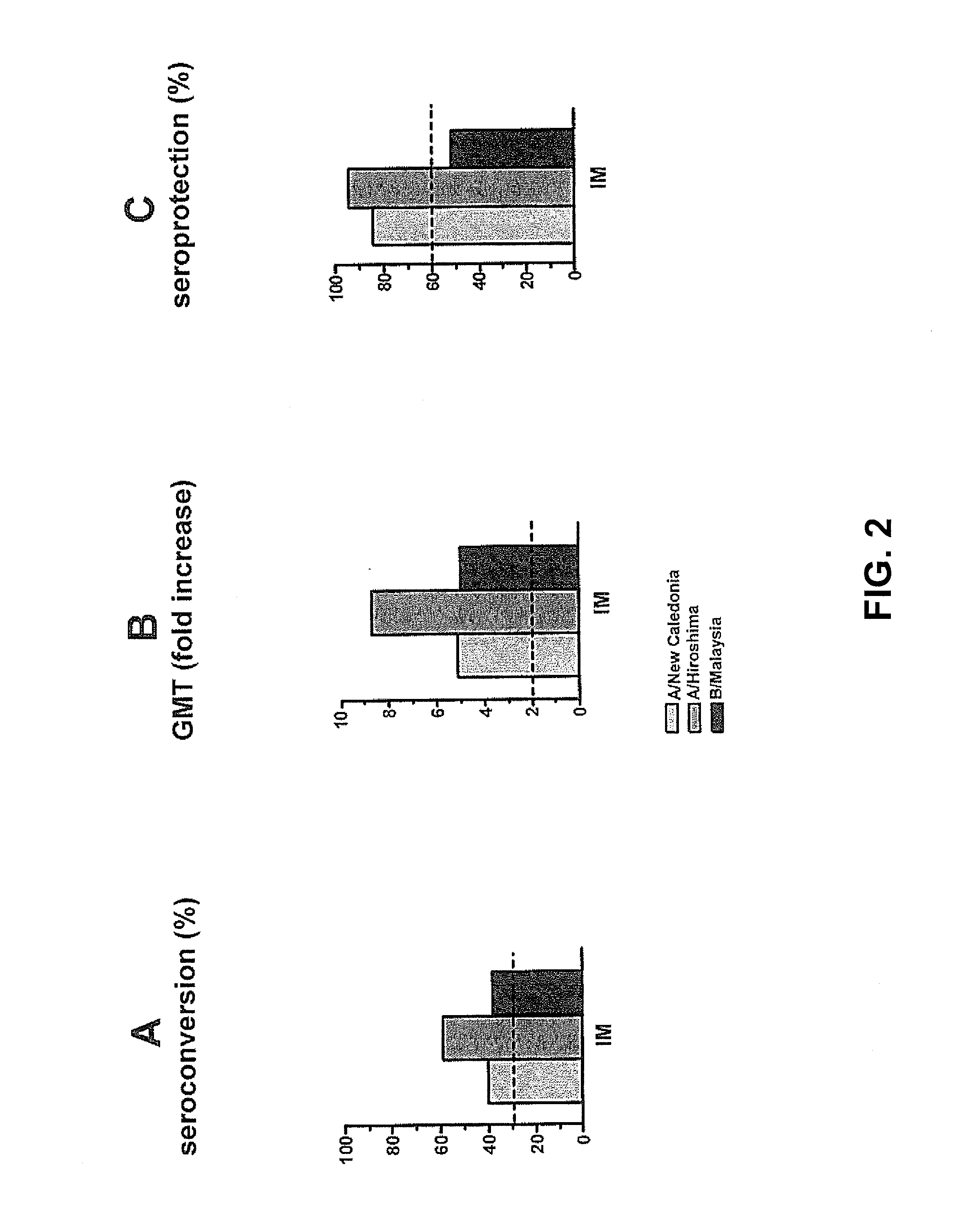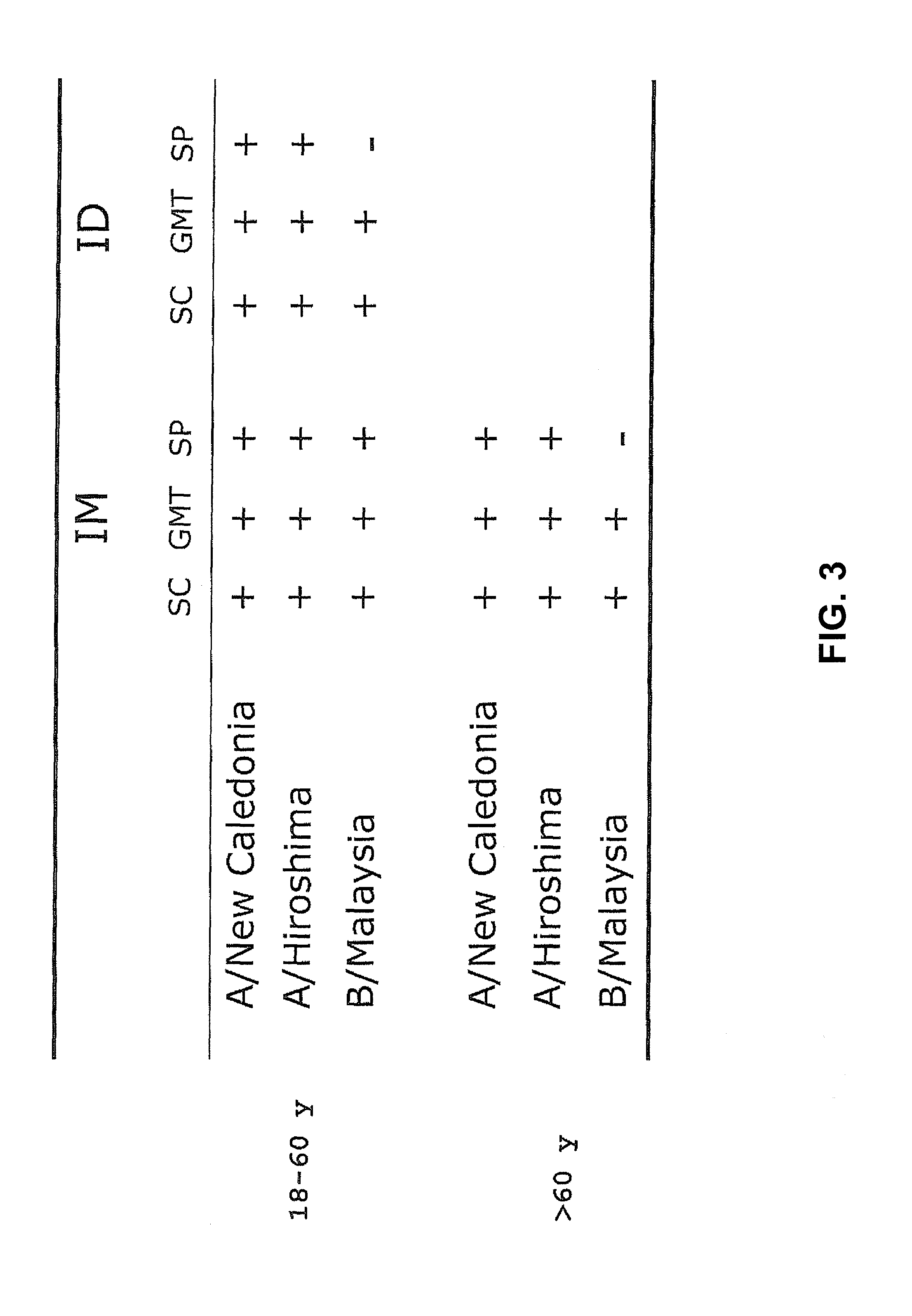Intradermal influenza vaccine
a technology of intradermal influenza and influenza ha, applied in the field of medicine, can solve the problems of insufficient seroconversion, seroprotection, gmt-fold increase level of influenza ha antigen in animals, and achieve the effect of convenient administration of vaccines and reduced volumes
- Summary
- Abstract
- Description
- Claims
- Application Information
AI Technical Summary
Benefits of technology
Problems solved by technology
Method used
Image
Examples
example 1
Clinical Trial with Virosome-Based Influenza Vaccine in Human Subjects (3 μg HA of Each Strain)
[0056]A clinical trial with human subjects was performed with INFLEXAL® V to evaluate the safety and the humoral responses of an intradermally administered vaccine in a nested study group. The study was open and non-randomized. The vaccine that was used was the trivalent virosomal adjuvanted influenza vaccine INFLEXAL® V vaccine that was being developed and studied for the 2006-2007 flu season. One dose of this intramuscular vaccine contained (originally) 15 μg hemagglutinin of each of the three following influenza strains: A / New Caledonia / 20 / 99 (H1N1; IVR-116), A / Hiroshima / 52 / 2005 (H3N2; IVR-142; an A / Wisconsin / 67 / 2005-like virus) and B / Malaysia / 2506 / 2004 coupled to virosomes in 0.5 mL solvent. The intradermal administration was performed with a 20% part of the vaccine: a single dose of 0.1 mL containing 3 μg HA of each influenza strain, using a normal injection syringe with needle. The ...
example 2
Dose Escalation (and an Intramuscular vs. Intradermal) Study with Virosome-Based Influenza Vaccines in Human Subjects
[0059]A second clinical study involving human individuals was performed to evaluate the humoral immune response of an intradermally administered seasonal virosomal adjuvanted influenza vaccine. This involved a single-center, randomized, dose escalation study wherein the trivalent INFLEXAL® V influenza vaccine for the 2007 / 2008 flu season was administered intradermally in a volume of 0.1 mL, and wherein a dose comprised 3, 4.5 or 6 μg HA of each strain (A / Solomon Islands / 3 / 2006 [H1N1]; A / Wisconsin / 67 / 2005 [H3N2]; B / Malaysia / 2506 / 2004). The intramuscularly delivered vaccine was taken as a positive control (containing 3×15 μg HA per strain in a 0.5 mL dose). Furthermore, it was tested whether a microneedle device developed by NanoPass (herein generally referred to as a MicronJet device) could also be used to deliver the antigen intradermally, and whether beneficial resul...
PUM
| Property | Measurement | Unit |
|---|---|---|
| volume | aaaaa | aaaaa |
| time | aaaaa | aaaaa |
| volume | aaaaa | aaaaa |
Abstract
Description
Claims
Application Information
 Login to View More
Login to View More - R&D
- Intellectual Property
- Life Sciences
- Materials
- Tech Scout
- Unparalleled Data Quality
- Higher Quality Content
- 60% Fewer Hallucinations
Browse by: Latest US Patents, China's latest patents, Technical Efficacy Thesaurus, Application Domain, Technology Topic, Popular Technical Reports.
© 2025 PatSnap. All rights reserved.Legal|Privacy policy|Modern Slavery Act Transparency Statement|Sitemap|About US| Contact US: help@patsnap.com



